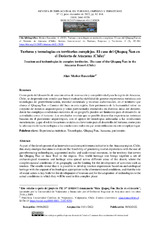Mostrar el registro sencillo del ítem
Turismo y tecnologías en territorios complejos. El caso del Qhapaq Ñan en el Desierto de Atacama (Chile)
| dc.contributor.author | Muñoz Bascuñán, Alan | |
| dc.date.accessioned | 2022-12-27T11:23:15Z | |
| dc.date.available | 2022-12-27T11:23:15Z | |
| dc.date.issued | 2022 | |
| dc.identifier.issn | 2530-7134 | |
| dc.identifier.uri | http://hdl.handle.net/10396/24470 | |
| dc.description.abstract | Como parte del desarrollo de una iniciativa de innovación y competitividad para la región de Atacama, Chile, se desprende este estudio que buscó evaluar la viabilidad de generar experiencias turísticas con tecnologías de georreferenciación, realidad aumentada y recursos audiovisuales, en el territorio que abarca el Qhapaq Ñan o Camino del Inca en esta región. Este patrimonio de la humanidad reúne un conjunto de recursos arqueológicos y sitios patrimoniales extendidos en distintas áreas del desierto, donde las complejas condiciones naturales de su geografía pueden ser limitantes para el desarrollo de actividades como el turismo. Los resultados revelan que es posible desarrollar experiencias turísticas basadas en el patrimonio arqueológico, con el apoyo de tecnologías adecuadas a las condiciones mencionadas, y que el rol de los actores sociales es clave tanto para el desarrollo del turismo, como para la adecuación de las tecnologías a las condiciones reales en que serán utilizadas en este complejo lugar. | es_ES |
| dc.description.abstract | As part of the development of an innovation and competitiveness initiative in the Atacama region, Chile, this study emerges that aims to evaluate the feasibility of generating tourist experiences with the use of georeferencing technologies, augmented reality and audiovisual resources, in the territory that covers the Qhapaq Ñan or Inca Trail in the region. This world heritage site brings together a set of archaeological resources and heritage sites spread across different areas of the desert, where the complex natural conditions of its geography can be limiting for the development of activities such as tourism. The results reveal that it is possible to develop tourism experiences based on archaeological heritage with the support of technologies appropriate to the aforementioned conditions, and that the role of social actors is key both for the development of tourism and for the adaptation of technologies to the actual conditions in which they will be used in this complex place. | es_ES |
| dc.format.mimetype | application/pdf | es_ES |
| dc.language.iso | spa | es_ES |
| dc.publisher | UCOPress | es_ES |
| dc.rights | https://creativecommons.org/licenses/by-nc/4.0/ | es_ES |
| dc.source | Revista Internacional de Turismo, Empresa y Territorio (RITUREM) 6(2), 82-104 (2022) | es_ES |
| dc.subject | Experiencias turísticas | es_ES |
| dc.subject | Tecnologías | es_ES |
| dc.subject | Qhapaq Ñan | es_ES |
| dc.subject | Atacama (Chile) | es_ES |
| dc.subject | Patrimonio | es_ES |
| dc.subject | Tourism experiences | es_ES |
| dc.subject | Technologies | es_ES |
| dc.subject | Heritage | es_ES |
| dc.title | Turismo y tecnologías en territorios complejos. El caso del Qhapaq Ñan en el Desierto de Atacama (Chile) | es_ES |
| dc.title.alternative | Tourism and technologies in complex territories. The case of the Qhapaq Ñan in the Atacama Desert (Chile) | es_ES |
| dc.type | info:eu-repo/semantics/article | es_ES |
| dc.relation.publisherversion | http://www.uco.es/ucopress/ojs/index.php/riturem/index | es_ES |
| dc.rights.accessRights | info:eu-repo/semantics/openAccess | es_ES |

